
A liquid scintillator neutrino detector
Introduction
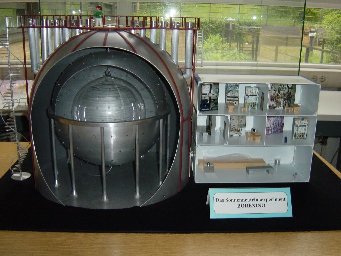 |
In astroparticle physics, a great importance is attached to the field of solar neutrinos. Besides the possibility to study the intrinsic properties of neutrinos, they themselves provide an exceptional way to look deep into the core of our sun. By studying their flux, one will be able to probe and eventually improve the widly accepted Standard Solar Model.
In recent years, several detectors have been constructed in order to observe the solar neurinos. The most widely known are Super-Kamiokande and SNO. As both experiments are water Cherenkov detectors, their energy threshold of ~5 MeV for neutrino detection limits the observations to the high energetic tail of the solar neutrino spectrum consisting of 8B and hep neutrinos.
Thus, there arises a necessity for detectors that are capable to observe the neutrino flux at lower energies. Liquid-scintillator detectors like the Borexino or the KamLAND experiment are able to detect neutrinos down to an energy of several hundred keV, provided the intrinsic radioactive background of the experiment is low enough. The Borexino experiment was designed to meet this ultra low background requirements. It will therefore be able to measure the fluxes of 7Be, pep and CNO neutrinos which will provide knowledge about the physics of both the sun and neutrinos.
The Detector
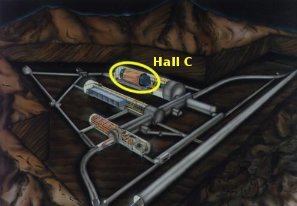 |
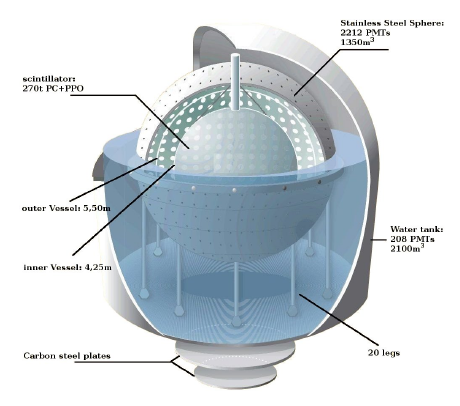 |
- The Borexino experiment is located in hall C of the Laboratori Nazionali del Gran Sasso. It is situated 150 km north-east of Rome in the Gran Sasso massive. The altitude of the rock cover is 1400 m (3800 m.w.e. (=meter water equivalent)). The rock is used as a shielding against cosmic radiation and features good radiopurity conditions.
- The experiment is contained in a stainless steel dome of 18 m in diameter and consists of the Outer Detector (OD) and the Inner Detector (ID).
The OD serves as shielding against external radioactivity and as a veto for cosmogenic muons. It is filled with 2400 tons of ultra pure water and is equipped with 208 PMT's.
The ID consists of a stainless steel sphere and two nested nylon vessels for radiopurity purposes. There are 2200 PMT's installed inside. It is filled with 1040 tons of shielding liquid outside and 280 tons of liquid scintillator (with a fiducial volume of 100 tons) inside the inner nylon vessel. - The liquid scintillator is based on PC (1,2,4-trimethylbenzene C6H3(CH3)3) as it provides high light yield and attenuation and scattering length suitable for the geometric configuration.
First real time detection of Be7 solar neutrinos
After long years of construction, Borexino started to take data on May 16th, 2007. Only three months later, the first results on the detection of solar Be7 neutrinos could be published (astro-ph/0708.2251,PLB-D-07-00772R2). It was the first real-time spectral measurement of sub-MeV solar neutrinos. After 47.4 life days of data-taking, the measured event rate of (0.862 MeV) Be7 neutrinos is 47 +/- 7 (stat) +/- 12 (sys) counts/(day x 100 ton). The value is consistent with predictions of the Standard Solar Models and neutrino oscillations with LMA-MSW parameters.
The figure below show the energy spectrum of both neutrino and background events inside the fiducial volume (i.e. the inner-most 100 tons of liquid scintillator). The relevant neutrino window for Be7 neutrino detection stretches from 270 keV to 800 keV of detected energy. The left figure depicts a fit that was done to the "Compton" shoulder of the Be7 neutrino events above 560 keV, in this way avoiding the background of events due to Po210 alpha-decays. The right figure shows the fit to the whole spectral region after a subtraction of the Po210 peak by alpha/beta-discrimination. Both fit results agree fully within the quoted errors. In both cases, contributions of Kr85, Bi210 decays and CNO neutrino events were considered as well. For further details see the publication quoted above.

Solar Neutrino Physics
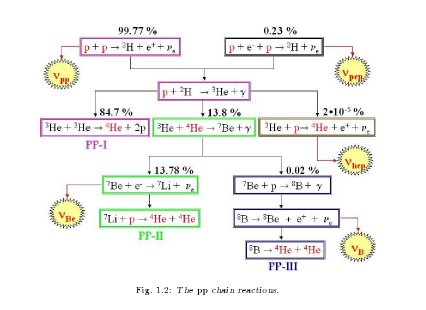 |
 |
The energy production in the sun is maintained by thermonuclear fusion. The main channel of energy production is the pp-chain (98%). Several subprocesses in this chain contribute to a continuous energy distribution of electron neutrinos. The spectrum ranges from 0 to 18 MeV and contains several mono-energetic lines, as shown in the left figure.
Due to its low energy threshold, Borexino will be able to measure the fluxes of 7Be, pep and CNO neutrinos that have not been observed directly so far. The detection reaction is the elastic neutrino-electron scattering. However, the sensitivity will be determined by the intrinsic radioactive background present in the scintillator.
- 7Be neutrinos are emitted at a fixed energy of 862 keV and are expected at a rate of 35 events per day. The recoil spectrum of the observed electrons will feature a "Compton-edge" at ~660 keV.
The 7Be neutrino flux is at the moment only poorly determined by experimental evidence. Borexino aims to measure this flux at a precision of 10%. In addition, this will allow to reduce the uncertainty on the pp flux using the constraints of the Sun's luminosity. Apart from solar physics, the 7Be neutrinos are also interesting in terms of particle physics: their energy places them near to the low-energy side of the transition region from vacuum-dominated to matter-dominated oscillations at higher energies. A measurement of their survival propability tests the predictions of the MSW effect and will allow to look for possible subdominant effects. - pep neutrinos are linked very closely to the flux of pp neutrinos via the Standard Solar Modell, making only few assumptions. The measurement of their flux is therefore almost equivalent to the measurement of the pp neutrino flux itself. Moreover, their energy of 1.44 MeV sets them directly in the transition region of vacuum to matter oscillations. Like 7Be, their measurement can validate the MSW theory and might provide evidence of subdominant processes.
- CNO neutrinos. A small contribution to solar energy production is made outside the pp-chain by the CNO cycle that also produces a detectable flux of neutrinos. Up to now, it is experimentally almost undetermined. In spite of its minor relevance in the sun, the CNO process plays an important role in heavier stars and is therefore of large astrophysical interest.
Antineutrino Physics
A liquid-scintillator detector is able to detect electron-antineutrinos via the inverse beta decay reaction, anti-ve+p -> n+e+. The delayed coincidence of the positron signal and the gamma quantum produced in the subsequent capture of the neutron on a proton of the scintillator is a prominent event signature and allows for excellent background rejection.
Several antineutrino sources can be investigated in Borexino:
- Solar antineutrinos. Non-standard physics mechanisms as the interaction of a non-zero magnetic moment of the neutrino with the magnetic fields of the sun might flip a solar neutrino into an antineutrino. The sensitivity of Borexino will be comparable to the KamLAND sensitivity due to the low reactor antineutrino background at the LNGS.
- Geoneutrinos. The comparatively large distance to the next nuclear reactors is favourable for the detection of antineutrinos generated in the decay of radioisotopes embedded in crust and mantle of the Earth. These so-called geoneutrinos are emitted by the radioactive 40K and the decay chains of 238U and 232Th. Together, these elements are responsible for about half of the Earth's heat production. Whereas the endpoint energy of the 40K beta-decay is too low to be detected via the inverse beta decay, both U and Th neutrinos are detectable. Borexino will therefore be able to measure the U/Th abundancies in the Eurasian continental crust. In combination with the KamLAND results, this could be used to disentangle the contributions from continental and oceanic crust to the Earth's heat flow.
In March 2013, the Borexino collaboration has released a new result on the geo-neutrino measurement: www.interactions.org/cms/
- Reactor long baseline. As there are no nuclear power plants in Italy, the average distance to the gros of European power reactors from the LNGS is ~ 800 km. This will enable Borexino to test the disappearance of the emitted antineutrinos as a long-baseline detector and to cross-check the KamLAND results.
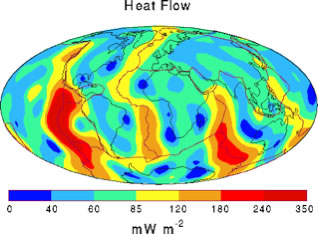
Supernova physics
The explosion of a core-collapse supernova in our galaxy will be visible as a neutrino burst of 10 sec duration in Borexino. The neutrinos that are cooling the emerging neutron star are generated in all (anti-)flavours. In liquid scintillator, there is a number of different reaction channels that will allow to observe energy and flux of the neutrinos at least partially sensitive to their flavour.
Event numbers for the different detection channels are given in the table to the right, along with the assumptions about the mean neutrino energy and the total cross section of the reaction. The progenitor is chosen to be an eight solar mass progenitor star at the center of our galaxy, 10 kpc away.
Diploma and Doctoral Theses
- Q. Meindl, Reconstruction and Measurement of Cosmogenic Signals in the Neutrino Experiment Borexino, PhD Thesis, Technische Universitaet Muenchen, June 2013
- F. Thorne, Spectral Analysis of Neutrino and Background Events in the Solar Neutrino Experiments Borexino and LENA, Diploma Thesis, Technische Universität München, December 2010
- M. Wurm, Cosmic Background Discrimination for Rare Neutrino Event Search in Borexino and LENA, PhD Thesis, Technische Universitaet Muenchen, June 2009
- Q. Meindl, Identification of Cosmogenic Background Signals in the Neutrino Experiment Borexino, Diploma Thesis, Technische Universität München, 2008
- T. Lewke, Calibration and Efficiency Determination of the Borexino Muon Veto Based on the First Realtime Measurements of 7Be Solar Neutrinos, Diploma Thesis, Technische Universität München, 2007
- D. D'Angelo, Towards the detection of low energy solar neutrinos in Borexino: Data Readout, Data Reconstruction and Background Identification, PhD Thesis, Technische Universität München, 2005
- L. Niedermeier, High Efficiency Purification of Liquid Scintillators for the Solar Neutrino Experiment Borexino, PhD Thesis, Technische Universität München, 2005
- C. Lendvai, Photomultiplier-Einkapselung für das Myon-Veto des Borexino-Experiments und messung myoninduzierter Neutronen in der CTF II, Diploma Thesis, Technische Universität München, 2001 (zip-Version)
- M. Göger-Neff, Development of a Liquid Scintillator and of Data Analysis Methods for BOREXINO , Doctoral Thesis, Technische Universität München, 2001 (zip-Version)
- L. Niedermeier, Untersuchungen zur Reinheit von Szintillatorkomponenten im Rahmen des solaren Neutrinoexperiments Borexino, Diploma Thesis, Technische Universität München, 2000 (zip-Version)
- T. Hagner, Messungen und Untersuchungen zur Bestimmung des kosmogenen Untergrunds im solaren Neutrinoexperiment BOREXINO, Doctoral Thesis, Technische Universität München, 2000 (zip-Version)
- T. Riedel, Spektroskopische Untersuchungen der Reinheit verwendeter Materialien im Sonnenneutrinoexperiment BOREXINO, Diploma Thesis, Technische Universität München, 1999 (zip-Version)
- R. v. Hentig, Spurenanalyse primordialer Radionuklide für das solare Neutrinoexperiment BOREXINO, Doctoral Thesis, Technische Universität München, 1999 (zip-Version)
- T. Goldbrunner, Messung niedrigster Aktiviäten für das solare Neutrinoexperiment BOREXINO, Doctoral Thesis, Technische Universität München, 1997 (zip-Version)
- G. Angloher, Untersuchungen zur Reinheit von Komponenten des BOREXINO Detektors, Diploma Thesis, Technische Universität München, 1997
- R. v. Hentig, Neutronenaktivierungsanalysen von Komponenten des Sonnenneutrinoexperimentes BOREXINO, Diploma Thesis, Technische Universität München, 1996
- M. Neff, Untersuchungen zum Untergrund durch Radioaktivität und kosmische Strahlung im Sonnenneutrinoexperimentes BOREXINO, Diploma Thesis, Technische Universität München, 1996
Borexino and Neutrino related Publications:
- F. v. Feilitzsch for the BOREXINO-Collaboration "Solar Neutrino Spectroscopy with BOREXINO" Proc. of the IV Int. Symposium on Weak and Electromagnetic Interactions in Nuclei, Osaka Japan, Ed. H. Ejiri, T. Kishimoto, T. Sato, World Scientific, 12-16 June, (1995)
- J. Jochum for the BOREXINO-Collaboration, "On the BOREXINO Solar Neutrino Experiment", Proc.of 3rd Tallin Symposium on Neurino Physics, Tallin, Estonia, Oct. 7 -11, (1995)
- S. Schönert et al., "Solar Neutrino Spectroscopy with the Borexino Detector and Preliminary Results from the CTF Experiment", Proceedings of the II.Rencontres du Vietnam, Saigon, Vietnam, Oct. 1995, Edt.Tran Thanh Van, Edition Frontieres, (1995)
- G.P. Bellini et al., "The Borexino Experiment and the Results of the Counting Test Facility", Nucl. Phys. B, (Proc. Suppl.) 48, 363, (1996) Topics in Astroparticle and Underground Physics TAUP95, Toledo, Spain, September, (1995)
- T. Goldbrunner et al., "Neutron Activation Analysis of Detector Components for BOREXINO", Proc. 1st SFB Workshop at Ringberg Castle, SFB375/P001, 11 (1995)
- F. v. Feilitzsch, T. Hagner for the BOREXINO-Collaboration,"Solar Neutrino Spectroscopy with BOREXINO and Preliminary Results from the CTF Experiment", Proc. of the VIIIth Rencontres de Blois, Blois, 8 - 12 June, (1996)
- T. Goldbrunner et al., "New Records on Low Activity Measurements with Neutron Activation Analysis", Nucl. Phys. B (Proc. Suppl.) 61B, 176, (1998) of "International Conference on Advanced Technology and Particle Physics", Como, 7 - 11 October 1996
- S. Schönert, "Spectroscopy of Solar Neutrinos: Present Status and Future Prospectives", Proceedings of the International School of Subnuclear Physics, 34th Course: Effective Theories and Fundamental Interactions, Erice, Italy, 1996, Edt. G. Veneziano and A. Zichichi
- T. Goldbrunner, "Spectroscopy of Solar Neutrinos with BOREXINO", Proc. of Workshop of Dark Matter, Heidelberg, September, (1996)
- T. Goldbrunner at al., "Neutron activation Analysis of Detector Components for the Solar Neutrino Experiment BOREXINO", J. Radioanal. Nuc. Chem. 216(2), 293-297, (1997)
- F. v. Feilitzsch for the BOREXINO-Collaboration, "Solar Neutrino Spectroscopy with BOREXINO and Recent Results from the CTF Experiment", Proc. of 4th International Solar Neutrino Conference, Heidelberg, April 1997
- R. v. Hentig for the BOREXINO-Collaboration, Determination of Background Sources in BOREXINO", Proc. of 9th International School Particles and Cosmology, Baksan, (1997)
- M. Altmann, F. v. Feilitzsch, "Das Sonnenneutrinorätsel", Naturwissenschaften 84, 105-116 (1997)
- S. Schönert, "Probing the Solar MSW Large Mixing Angle Solution with Terrestial Antineutrinos from European Nuclear Reactors with BOREXINO", Proc. of Topics in Astroparticle and Underground Physics TAUP97, Laboratori Nazionali del Gran Sasso, Italy, Sept. 7 -11, (1997)
- T. Goldbrunner et al., "Spectroscopy of Solar Neutrinos with BOREXINO", Proc. of High Energy Physics HEP97, Jerusalem, Israel, Aug. 19 - 26, (1997 )
- L. Oberauer, "Neutrino Masses", Proc. of Topics in Astroparticle and Underground Physics TAUP97, Laboratori Nazionali del Gran Sasso, Italy, Sept. 7 -11, (1997)
- L. Oberauer, "BOREXINO", Proc.of SFB Workshop on Neutrino Astrophysics at Ringberg Castle, Okt. 20 - 24, (1997)
- F. v. Feilitzsch, "The Borexino Solar Neutrino Experiment", International School of Nuclear Physics, 19th Course: Neutrinos in Astro, Particle and Nuclear Physics, Erice, Italy, 16 - 24 September, (1997)
- R. v. Hentig et al., "Determination of Naturally Occurring Radionuclides in Ultrapure Organic Liquids", Fres. J. Anal. Chem. 360(6), 664, (1998)
- G. Angloher et al., "Neutron Activation Analysis of Ultrapure Liquids in a 500ml Silicon Single Crystal Irradiation Flask", Proc. of Conference of Methods and Applications of Radioanalytical Chemistry Marc IV, Hawaii, J. Radioanal. Nuc. Chem. 234(1), 37-42, (1998)
- T. Goldbrunner et al., "Ultrasensitive Determination of U, Th, K in Liquid Organic Scintillators", Proc. Conference of Methods and Applications of Radioanalytical Chemistry Marc IV, Hawaii, Radioanal. Nuc. Chem., 234(1), 43-50, (1998)
- R.S. Raghavan, S. Schönert et al.,"Measuring the Global Radioactivity in the Earth by Multidetector Antineutrino Spectroscopy", Phys. Rev. Let. 80(3), 635-638, (1998)
- L.Oberauer, S. Schönert, Status Report on the Muon Identification System, (1998)
- L.Oberauer, "Future Solar Neutrino Experiments", May 24-29, Proc.of Ringberg Euroconference: New Trends in Neutrino Physics, Ringberg Castle, Tegernsee, (1998)
- G. Alimonti et al., "Ultra Low Background Measurements in a Large Volume Underground Detector", Journal of Astroparticle Physics 8, 141, (1998).
- S. Schönert et al.,"Measurement of the 14C Abundance in a Low Background Liquid Scintillator", Nucl. Phys. B, 422/1-4, 349-358, (1998)
- G. Alimonti et al., "A Large Scale Low Background Liquid Scintillator Detector: The Counting Test Facility at Gran Sasso", Nucl. Instr. Meth. A, 406, 411, (1998)
- C. Hagner, "Low Energy Neutrino Astronomy - Solar Neutrinos", Proc. of Physics at Cosmic Accelerators, April 1-5, Burg Liebenzell, Germany, (1998)
- S. Schönert, "N.N.", Proc. of XXXIIInd Rencontres de Moriond, March 14-21, Les Arcs, France, (1998)
- L. Oberauer, "Status of astrophysical neutrino experiments and prospects", Proc. of the International Workshop XXVI on Gross Properties of Nuclei and Nuclear Excitations, January 11 - 17, Hirschegg, Austria, (1998)
- S. Schönert, L. Oberauer, "Long Baseline Reactorneutrino Experiment with Borexino", NOW 98, Amsterdam, Netherlands (1998)
- R. v. Hentig et al., "Determination of Radioactive Trace Elements in Ultra Low Background Detectors by Means of Neutron Activation Analysis", Czech. J. Phys., 49 Suppl. S1, 277-286, (1999)
- M. Altmann, L. Oberauer, "Neutrino Physics at the Dawn of the 21st Century", Naturwissenschaften 86, 571-583 (1999)
- F. v. Feilitzsch, "Solar Neutrino Spectroscopy", Proc. of Topics in Astroparticle and Underground Physics TAUP97, Laboratori Nazionali del Gran Sasso, Italy, Sept. 7 -11, 1997, Nucl. Phys. B. (Proc. Suppl.), 70/1-3, 292-300, (1999)
- L.Oberauer, "Status of the BOREXINO Solar Neutrino Experiment", June 4-9, Proc. of Neutrino98, Takayama, Japan, Nucl. Phys. B (Proc. Suppl.) 77, 48-54, (1999)
- R. v. Hentig et al., "Records in Ultra Low Radioactivity Measurements with Neutron Activation Analysis", Proc. of "International Conference on Advanced Technology and Particle Physics", Como, October 5-9 1998, Nucl. Phys. B (Proc. Suppl.) 78, 115-119, (1999)
- M. Altmann, L. Oberauer, "Neutrino Physics at the Dawn of the 21st Century", Naturwissenschaften 86, 571-583 (1999)
- T. Hagner, R. v.Hentig, B. Heisinger, L. Oberauer, S. Schönert, F. v.Feilitzsch, E. Nolte, "Muon induced Production of Radioactive Isotopes in Scintillation Detectors", Astroparticle Physics 14, 33-47, (2000)
- G. Alimonti et al., "Light Propagation in a Large Volume Liquid Scintillator", Nucl. Inst. Meth. A, 440, 360-371, (2000)
- L. Oberauer, "Status of the BOREXINO Solar Neutrino Experiment", Proceedings of the CAPP-2000 Conference, Verbier, Switzerland, 2000
- Borexino Collaboration, "Science and Technology of BOREXINO: a real-time Detector for Low Energy Solar Neutrinos", Astroparticle Physics 16, 205 (2002)
- S. Schönert, T. Lasserre, L. Oberauer, "The HLMA project", hep-ex/0203013 (2002)
- Borexino Collaboration, "Search for electron gamma-neutrino-decay-mode with prototype of Borexino collector", Physics Letters B525, 29 (2002)
- F. v. Feilitzsch, "Present Status of BOREXINO", First Sendai International Conference on Neutrino Science, Japan (2002)
- Borexino Collaboration, "Measurements of extremely low radioactivity levels in BOREXINO", Astroparticle Physics 18, 1 (2002)
- L. Oberauer, C. Grieb, F. v. Feilitzsch, I. Manno, "Light Concentrators for the Solar Neutrino Experiment Borexino", NIM A 530 (2003) 453
- L. Niedermeier, C. Grieb, D. D'Angelo, G. Korschinek, L. Oberauer, F. v. Feilitzsch, "Scintillator Purification by Silica Gel - Chromatography in the context of Low Counting Rate Experiments", 8th ICATPP Conference, Como (2003)
- Borexino Collaboration, "Study of neutrino electromagnetic properties with the prototype of the Borexino detector", Phys. Lett. B 563 (2003) 35-47
- L. Oberauer, "Neutrinos", for the Encyclopedia of Physics, Wiley-VCH, Ed. R.G. Lerner, G.L. Trigg
- Borexino Collaboration, "New Experimental Limits on Heavy Neutrino Mixing in B-8-Decay Obtained with the Borexino Counting Test Facility", JETP Letters 78 (2003) 261
- Borexino Collaboration, "New limits on nucleon decays into invisible channels with the BOREXINO counting test facility", Phys. Lett. B 563 (2003) 23-34
- Borexino Collaboration, "New experimental limits on violations of the Pauli exclusion principle obtained with the Borexino Counting Test Facility", arXiv:hep-ph/0406252
- L. Oberauer, "LOW ENERGY NEUTRINO PHYSICS AFTER SNO AND KamLAND", Mod. Phys. Lett. A 19 (2004) 112
- Borexino Collaboration, "First real time detection of Be7 solar neutrinos by Borexino", arXiv:astro-ph/0708.2251v2
Related Talks
- L. Oberauer, "First Results from BOREXINO and Prospects of Low Energy Neutrino Astronomy", Oxford University, Nov 07.
Contact
If you are interested in a diploma or PhD thesis on this topic, please contact Prof. Lothar Oberauer.

